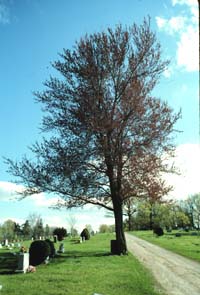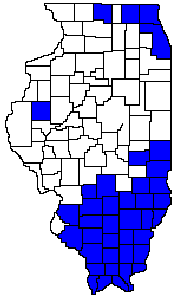 |
| Red
Maple (Acer rubrum)
Distribution
Map to Right |

Red maple, also referred to as scarlet maple, Drummond's red maple, swamp maple, soft maple, and water maple, is a medium-sized tree between 40-70 feet tall, with a trunk diameter of up to 3 feet. The trunk is relatively long and clear of branches and the crown is oval and irregular, or rounded.
Red maple grows over a wide array of habitats. In Illinois, red maple is present in the southern portion of the state and the extreme northeastern counties. It is not present in the Prairie Peninsula. It grows best on moist but well-drained soils, chiefly in floodplains, but also swamps, and low woods in the southern part of Illinois. It also grows on upland slopes and bluff tops.
Its range extends from southern Newfoundland and Nova Scotia, south along the eastern coast to southern Florida, west to southeastern Texas, northeast through the plains into southern Illinois, then northwest again from Ohio through Wisconsin to the western portion of northern Minnesota.
Interesting
Facts
Red maple
grows on a broad range of sites. It is present both in swamps and on dry
ridge tops. It occurs in well over half of the non-tropical forest types
in the eastern United States as either an associated or major tree type.
It is a tremendous seed producer and the seeds do not have very many requirements to germinate. Red maple seeds can germinate in shade, but shading can prevent germination until the second year. Mature trees are moderately tolerant of shade and often persist in the understory.
Red maple's ability to grow successfully on sites with very different moisture availability is due in part to the early development of roots specifically adapted to the conditions at a particular site. On wet sites, red maple develops a network of roots that extend and branch outward. On drier sites, a deeper tap root with fewer lateral branches develops early in growth. Red maple can tolerate flooding for extended periods of time.
Red maple is very sensitive to fire, and is a prolific stump sprouter, particularly after fire damage.
Identifying Features
Bark
Red maple bark is smooth and gray when young, becoming darker, fissured, and scaly with age.
Twigs
The twigs and buds are reddish. The twigs are slender, usually with numerous, pale lenticels (small openings or spongy areas in the cork surfaces that facilitate gas exchange between internal tissues and the atmosphere through the bark).
Buds
The buds are rounded, usually hairy, and from 1/8 to 1/4 inch long.
Leaves
The leaves are opposite, simple, and palmate with 3-5 lobes. The notches between the lobes are relatively shallow. Red maple leaves are up to 6 inches long and almost as broad. The edges are irregularly, sharply double toothed, varying to almost toothless. The upper surface is pale green and smooth and the underside is white or grayish, and can be hairy or smooth. Leaf stalks may be either smooth or hairy and are up to 4 inches long.
Flowers
Red maple is "polygamo-dioecious" - some trees bear only male or female flowers and others bear both male and female flowers. On trees with both male and female flowers, the two are borne on separate branches. Flowers appear in March through May before leafout, are red (sometimes yellow), and occur in dense clusters.
Fruits
Seeds are produced every year, with a larger crops produced every two years. Fruits are winged with a single seed at the base. They are up to an inch long and borne in pairs. They are red or yellow.
Uses
Red maple
wood is softer in texture than that of sugar maple, and is somewhat less
workable. It is called soft maple as opposed to hard maple (sugar maple)
in the lumber industry. The wood is heavy and close-grained, and used for
furniture and gun-stocks. The sap is comparable in quality to that of sugar
and black maple for making syrup. White-tailed deer and elk like to eat
the twigs.